The Animals Of Bhutan
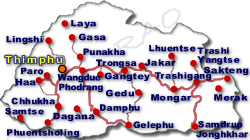 Three ecological units may be distinguished within Bhutan:
High - altitude,
temperate, and tropical.But there exists many wild animals around the country,
amongst them: Snow leopard, blue sheep, red panda, tiger, takin, marmot, and musk
deer are some of the species found in the high altitudes. Temperate zone fauna include
tiger, leopard, goral, serow, gray langur, macaques, Himalayan black bear, red panda,
squirrels, sambar, wild pig, and barking deer.
Three ecological units may be distinguished within Bhutan:
High - altitude,
temperate, and tropical.But there exists many wild animals around the country,
amongst them: Snow leopard, blue sheep, red panda, tiger, takin, marmot, and musk
deer are some of the species found in the high altitudes. Temperate zone fauna include
tiger, leopard, goral, serow, gray langur, macaques, Himalayan black bear, red panda,
squirrels, sambar, wild pig, and barking deer.
 |
The tropical forests in the south have tiger, clouded leopard, elephant, greater one-horned
rhinoceros, water buffalo, golden langur; gaur, swamp deer, hog deer, pygmy hog, hispid hare,
piliated langur, sloth bear, and hornbills.Some few are here:
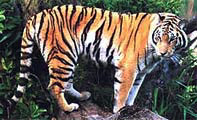 Bengal tigers, black panthers, snow leopards, marbled cats, gray wolves, red foxes, sloth bears,
pygmy hogs, Asian elephants, golden langurs - are among the 200 or so mammals found in Bhutan.
This rich diversity of mammal species will feature in the first ever illustrated guide to Bhutan's
mammals that is to be released towards the end of this year according to the department of forests, agriculture ministry.
Bengal tigers, black panthers, snow leopards, marbled cats, gray wolves, red foxes, sloth bears,
pygmy hogs, Asian elephants, golden langurs - are among the 200 or so mammals found in Bhutan.
This rich diversity of mammal species will feature in the first ever illustrated guide to Bhutan's
mammals that is to be released towards the end of this year according to the department of forests, agriculture ministry.
In fact people are regularly mauled by bears. Bears have attacked humans, destroyed crops, and cattle.
 The Himalayan black bear was usually aggressive when provoked and it was commonly believed that bears
could wait for up to nine years to avenge an injury.
The Himalayan black bear was usually aggressive when provoked and it was commonly believed that bears
could wait for up to nine years to avenge an injury.
Autumn is the bear's migratory season and time to prepare for hibernation so they are frequently out in the orchards.
The Himalayan Black bear falls under the Schedule I of protected animals in the Forest and Nature conservation Act.
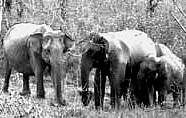 For more than a decade, the wild elephants have become an increasingly intolerable nuisance for the
farmers in the south. A herd of seven elephants completely wiped out about 300 kilogrammes of ginger,
100 kilogrammes of maize, and 100 jackfruits from farmer Sonka Uroan's five-acre field. The herd also destroyed his home.
For more than a decade, the wild elephants have become an increasingly intolerable nuisance for the
farmers in the south. A herd of seven elephants completely wiped out about 300 kilogrammes of ginger,
100 kilogrammes of maize, and 100 jackfruits from farmer Sonka Uroan's five-acre field. The herd also destroyed his home.
The distribution of golden langurs (Trachypithecus geei) is limited to a small area of western Assam in northeast
India and Bhutan between the rivers Manas (India) in the east,
 Sunkoshi in the west, and Brahmaputra in the south.
It is one of the most seriously endangered primate species of the subcontinent. It probably evolved in geographic
isolation on the western side of the Manas river. On the other side of the river is its close cousin, the capped langur.
No golden langurs are found on the river's eastern side.
Sunkoshi in the west, and Brahmaputra in the south.
It is one of the most seriously endangered primate species of the subcontinent. It probably evolved in geographic
isolation on the western side of the Manas river. On the other side of the river is its close cousin, the capped langur.
No golden langurs are found on the river's eastern side.
The snow leopard has long, thick smoky gray fur with dark rosettes and spots, and a very long thick tail.
Weighing up to 75 kg , it has large, well-cushioned paws, a strong chest, and short forelimbs that enable it to
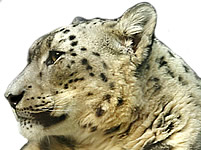 scale outcroppings high on cliffs. Further adaptations for high-altitude life include long hair with dense, woolly underfur and an enlarged nasal cavity.
scale outcroppings high on cliffs. Further adaptations for high-altitude life include long hair with dense, woolly underfur and an enlarged nasal cavity.
Sometime in the mid-70s, the government initiated the mass poisoning of wild dogs that terrorized farmers and fed on their
cattle. Most of the carnivores were killed and soon forgotten. Now after almost 22 years, the wild dogs are back.
This time the law is on their side.
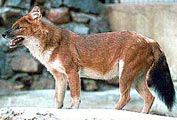 In lower Kheng region, Zhemgang dzongkhag, the carnivores are believed to be
on the rampage killing cattle and giving farmers sleepless nights. Wild dogs are a nightmare to farmers.
In lower Kheng region, Zhemgang dzongkhag, the carnivores are believed to be
on the rampage killing cattle and giving farmers sleepless nights. Wild dogs are a nightmare to farmers.
TThree ecological units may be distinguished within Bhutan: High - altitude,
770 bird species in Bhutan have been recorded and much still remain unknown.
Indo-Malayan and Pale arctic elements are among those that have been recorded. Approximately 73 percent are resident.

|